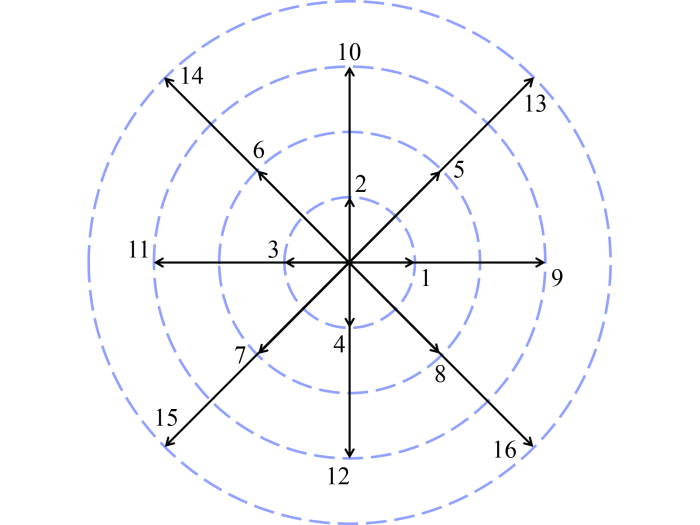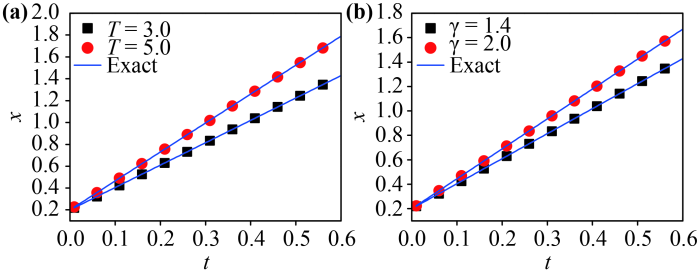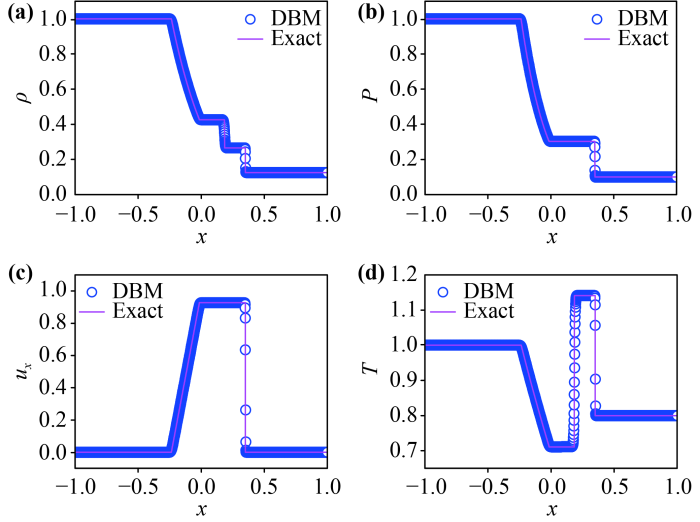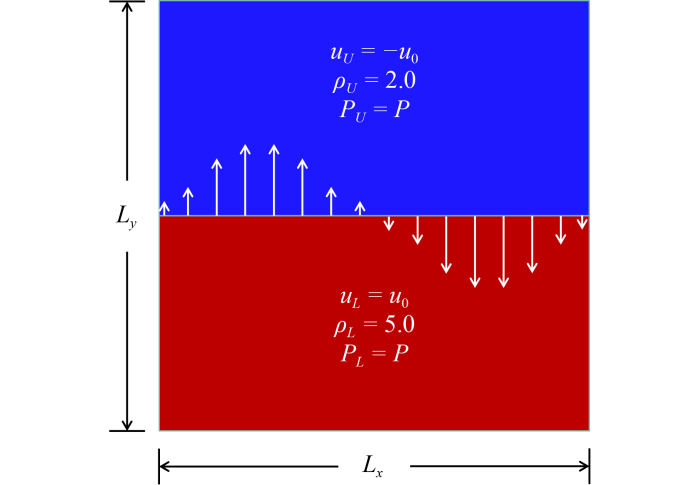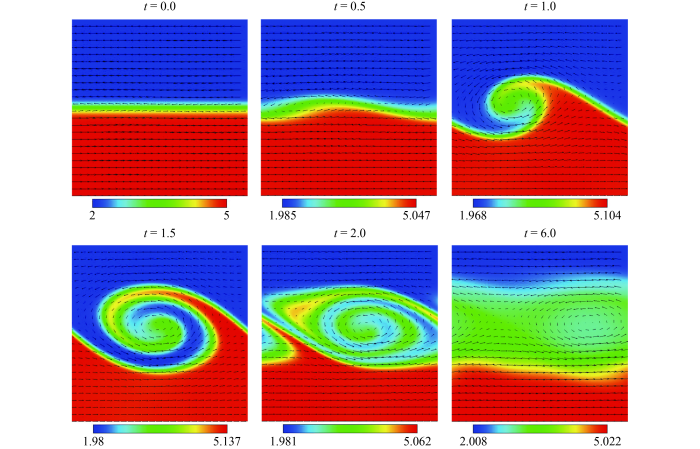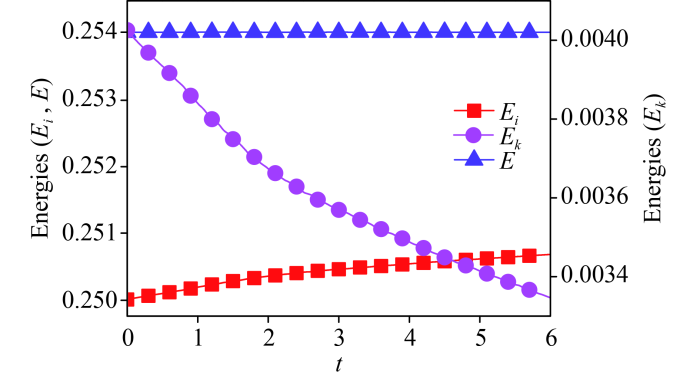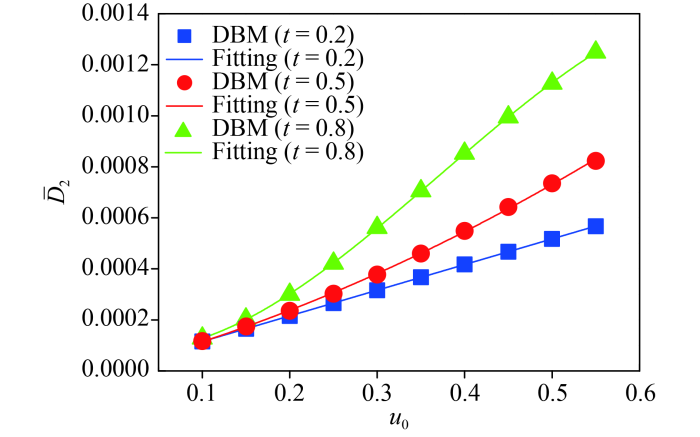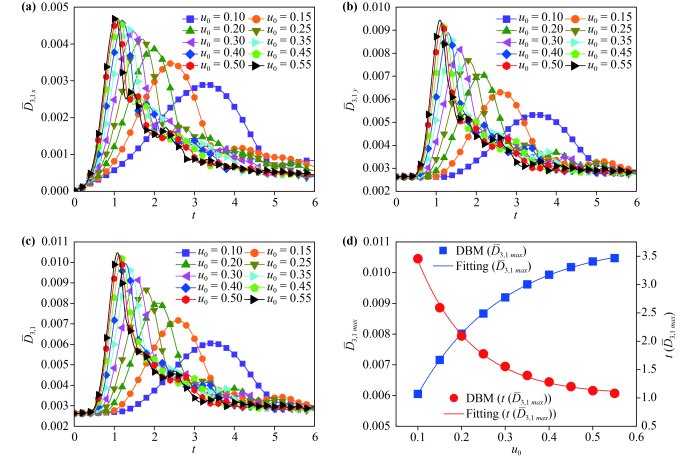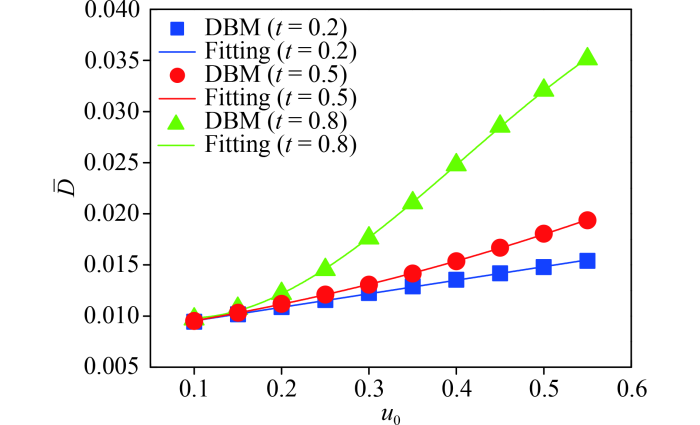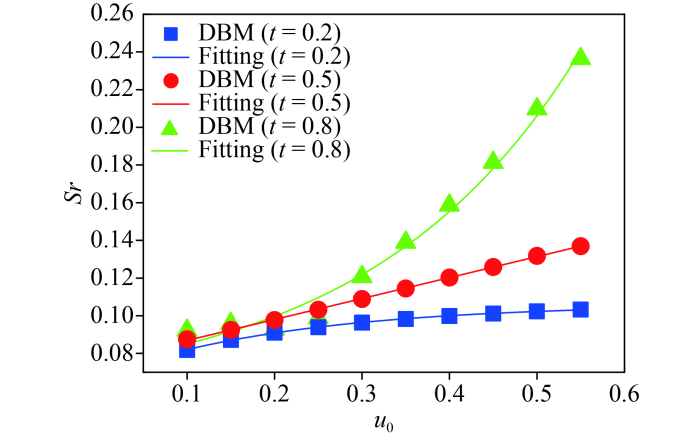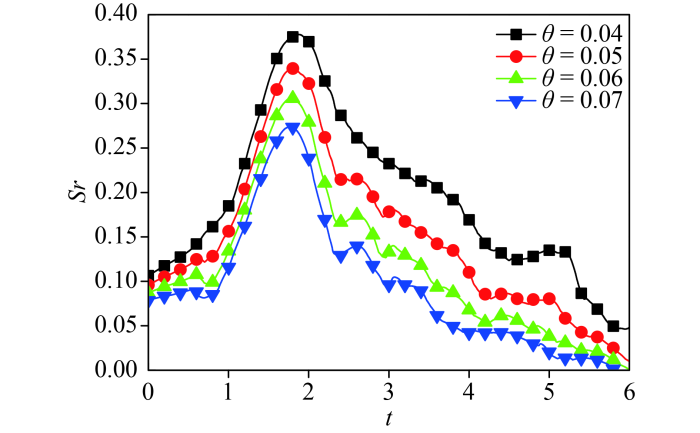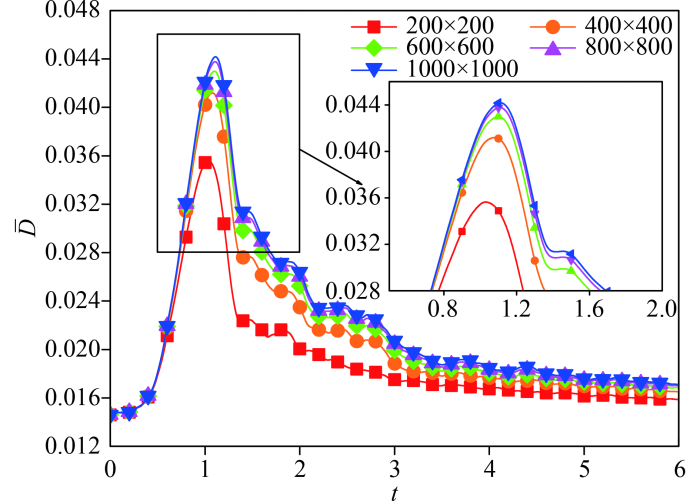To better understand the evolution of the KH system intuitively, Fig.6 illustrates the density and velocity fields at six different time instants, with the tangential velocity
. Obviously, the perturbed interface begins to distort, and the transition layer widens and bends significantly at
, due to the diffusion, dissipation and viscous shear. Subsequently, at
, the system continues to develop, and a small vortex structure becomes apparent near the interface. At
, a larger regular KH vortex is observed. Afterwards, a more complex vortex appears at
. At the later stage, the mixing of the upper and lower fluids deepens, the vortex structure gradually disappears. These findings are consistent with previous studies [
19,
43].
Fig.6 Density and velocity fields in the case of at times , , , , , and , respectively. |
Full size|PPT slide
Moreover, the energy budget is an important issue in the evolution of the KH instability [
56-
59]. In theory, the kinetic energy is converted into the internal energy due to the effect of viscous shear as the interface morphology becomes more and more complicated. Here, the energies of the KH instability are studied. Let us introduce the following definitions: the whole internal energy
, the whole kinetic energy
, and the total energy
, where the integral conducted over the whole computational region. In Fig.7, the lines with squares, circles and upper triangles indicate the internal, kinetic and total energies, respectively. It can be found that the internal energy
increases gradually, the kinetic energy
decreases simultaneously, and the total energy
has slight changes. That is to say, the kinetic energy changes into the internal energy in the KH process.
Fig.7 Evolution of the whole energies in the KH process. The lines with squares, circles and upper triangles are for the internal, kinetic and total energies, respectively. |
Full size|PPT slide
In order to study the hydrodynamic nonequilibrium effects of the compressible KH instability, ten groups of the tangential velocity are selected, where ranges from 0.10 to 0.55, with an interval of 0.05. Fig.8(a) shows the evolution of the global average density gradient in the direction with different values of , where . It can be seen that increases with the growing of before the leftmost peak (of ) at about . Moreover, for each , increases and then decreases as time goes on. Taking as an example, firstly increases before , and then decreases. Physically, there are two competitive mechanisms in the evolution of the KH instability. On the one hand, under the influence of the shear velocity, the perturbation amplitude increases in the direction, the fluid interface is distorted and gradually elongated, which enhances the physical gradients. On the other hand, due to the dissipation and/or diffusion effects, the transition layer becomes wider and small fluid structures disappear, which suppresses the physical gradients. In the rising (descending) stage, the former (latter) mechanism plays a leading role.
Fig.8 (a) Evolution of the global average density gradient in the direction under different tangential velocities . (b) The relationship among (defined as the maximum of ), (defined as the time corresponding to the peak of ) and , where the symbols indicate the DBM results, the blue solid line , and the red solid line . |
Full size|PPT slide
In Fig.8(b),
(defined as the maximum of
),
(defined as the time corresponding to the peak of
), and
show the following relationships:
, and
. Obviously,
increases exponentially while
decreases exponentially, with the increasing of
. Furthermore, it can be found that
is also a function of
, namely,
, and
declines exponentially as
increases. In fact, for a larger
, the system evolves rapidly, it takes less time to reach the peak value, the density structure in the
direction is more complex, and
becomes larger [
20,
25,
26].
Fig.9(a) plots the evolution of the global average density gradient in the direction under different tangential velocities , where . The global average density gradient in the direction keeps constant initially, then increases, and decreases afterwards. And grows with the increase of before the leftmost peak. Taking as an example, it can be found that almost keeps constant from to . At the beginning, the upper and lower density near the system interface is quite different. And the interface twists slightly, the density declines monotonously along the direction, hence is almost constant. Then, from to , increases rapidly and forms a peak around . In this process, the fluid interface is extended vertically, a regular vortex forms gradually, and the density no longer changes monotonously in the direction. In addition, compared with Fig.5, it can be found that increases rapidly when a vortex structure emerges. Finally, the physical gradients become smooth, the fluid interface gets blurred, and the vortex gradually disappears, as the fluid mixing deepens.
Fig.9 (a) Evolution of the global average density gradient in the direction under different tangential velocities . (b) The relationship among , and , where the symbols indicate the DBM results, the blue solid line , and the red solid line . |
Full size|PPT slide
Furthermore, the relationships among , and are shown in Fig.9 (b). Specifically, , and . ascents exponentially and descents exponentially as becomes large. Additionally, the formula can also be obtained. Clearly, the larger , the smaller , in an exponential declining trend. Physically, the larger is, the faster the system develops, the more complex the density changes, the larger the peak value becomes, and the less time it takes to reach the peak value.
Fig.10(a) delineates the evolution of the global average density gradient under different values, where . In fact, the tendency of can be obtained from the analysis of and in Fig.8(a) and Fig.8(a). Similarly, Fig.10(b) shows the relationship among , and . It can be seen that and . With the increase of , increases by an exponential function, while decreases exponentially. Besides, declines exponentially as grows, i.e., . The physical mechanisms are similar to those in Fig.8(b) and Fig.9(b).
Fig.10 (a) Evolution of the global average density gradient under different tangential velocities . (b) The relationship among , and , where the symbols indicate the DBM results, the blue solid line , and the red solid line . |
Full size|PPT slide
Fig.11(a) shows the simulation results and fitting curves of at three different times, with various tangential velocities . At the time , the relation between and reads . It can be found that increases slightly with the increasing of at the early stage. For different values of , the systems evolve slowly, and the interface has few changes initially. At a later time , the relation is . Clearly, the differences between become apparent. Physically, with the action of the shear, the fluid interface with a larger has twisted earlier, while the one with smaller has no obvious change. At , it can be found that . For the system with a larger , a vortex forms distinctly and the density changes with a strongly nonlinear trend. However, for a smaller , the fluid interface starts to curl or still has no significant change.
Fig.11 (a) The simulation results and fitting functions of with various tangential velocities at three different times: , , and . (b) The relationship between (the time corresponding to ) and at three different values: , , and . |
Full size|PPT slide
Fig.11(b) displays the relation between (the time corresponding to ) and tangential velocity at three different values. From the formula , it can be found that the larger , the smaller . Via the formulae and , the development trend of and is similar to that of . It indicates that the larger becomes, the more rapidly the system evolves, and the less time for to reach the same value takes. Moreover, the interface structure has complicated, and is large as time goes on.
Next, the TNE behaviors in the KH instability are discussed and analyzed. Fig.12(a) illustrates the global average viscous stress tensor strength
versus time. In general,
rises first and then declines over time, and increases with the increasing of
. Particularly, taking
as an example,
increases slowly from
to
. During this stage, as the viscous shear takes effect, the fluid interface gradually curls up. Then, from
to
,
grows rapidly, the peak is observed around
and a regular vortex emerges. When
, on account of the dissipation and/or diffusion, the KH vortex vanishes gradually and
declines. Fig.12(b) shows the relationship of
,
and
. The specific expressions are
and
.
increases linearly and
decreases exponentially as
increases [
60,
61]. Furthermore, it is easy to obtain the formula
. That is,
decreases exponentially with the increasing of
. Physically, the larger
is, the stronger the shear force is, and the faster two fluids mix.
Fig.12 (a) Evolution of the global average viscous stress tensor strength under different tangential velocities . (b) The relationship among , and , where the symbols indicate the DBM results, the blue solid line , and the red solid line . |
Full size|PPT slide
To understand the relationship between and in the early stage, Fig.13 plots the relations between and at three various times , , and , respectively. Details are as follows: , , and . Specifically, the larger is, the greater the viscous shear becomes, the faster the system evolves, the earlier the vortex forms, and the larger is. Additionally, in the initial stage, the system evolves almost linearly with the increasing of . And the system evolves nonlinearly afterwards, hence there is a nonlinear relation between and as time goes on.
Fig.13 The simulation results and fitting functions of the global average viscous stress tensor strength with various tangential velocities at three different times: , , and . |
Full size|PPT slide
Fig.14 describes the evolution of the TNE quantities , and . From Fig.14(a), for any , rises first then declines over time. Furthermore, before the leftmost peak, increases with the growing of . At the beginning, there is little temperature change in the direction, hence the corresponding temperature gradients are almost zero, and develops from zero. Afterwards, due to the viscous shear, the interface is elongated and twists gradually and the temperature field in the direction starts to get complicated. Therefore, rises rapidly. In the later stage, although the contact area of two fluids increases continuously, the vortex and small structures are dissipated gradually due to the diffusion and heat conduction, and consequently reduces.
Fig.14 Evolution of the global average heat flux strength: (a) in the direction , (b) in the direction and (c) , with different tangential velocities . (d) The relationship among , and , where the symbols indicate the DBM results, the blue solid line , and the red solid line . |
Full size|PPT slide
Fig.14(b) illustrates the evolution of . Similar to in Fig.14(a), there is a peak of in each case. For all cases, keeps constant in the early stage (roughly before ), then increases, and decreases later. And increases with the increasing of roughly before the leftmost peak. In fact, in the initial phase, there is a temperature difference between the two fluids, hence there is heat conduction across the interface and the value of is nonzero. Meanwhile, the temperature varies monotonously in the direction, so keeps constant. Then, the fluid structure becomes more and more complicated, the physical field in the direction changes no longer monotonously, and the heat exchange is enhanced, hence increases obviously. In the later stage, the interface gets blurred, the physical gradients become smooth, and decreases.
From Fig.14(c), it can be found that the evolutionary trend of is similar to that of . That is because the physical mechanism of can be acquired from that of and and dominated by the second component. Through the fitting method, the relationship among , and can be expressed as and , as seen in Fig.14(d). Furthermore, the formula can be derived as well. Physically, the fluid mixing deepens, the temperature gradients and the heat exchange are enhanced, in the system with a large . Additionally, the rapid evolution of the system and the large fluid contact area are caused by the large .
Fig.15(a) plots the relationships between and at three time instants , , and , respectively. Physically, as the fluid system evolves from to , the temperature field becomes more complex, and increases. Especially, the fitting functions are , , and , respectively. In addition, at an early time , increases slightly with the growing of . In the later period , the influence of is obvious.
Fig.15 (a) The simulation results and fitting functions of the global average heat flux strength with various tangential velocities at three different times: , , and . (b) The relationship between and at three different values: , , and . |
Full size|PPT slide
Fig.15(b) shows the relation between the velocity and the time when reaches a given value. Here three different cases , , and are under consideration. The following fitting formulae , , and can be obtained. It is obvious that declines exponentially when increases in each case. The tendencies of , and are similar to each other. The larger is, the more thoroughly the upper and lower fluids mix, and the more time it takes. In addition, the larger is, the more significantly the temperature gradients increase, the faster the heat exchange becomes, and the less time it requires to reach the same value.
To have a deeper understanding of nonequilibrium effects in the KH instability, the global average TNE strength is discussed next. As plotted in Fig.16(a), ascents first and descents later, and increases with the increasing of before the leftmost peak. Physically, there are two competitive physical mechanisms that affect the TNE effects during the KH process. On the one hand, the material interface between the two fluids is elongated and widened as the fluid structures become complicated, which promotes the development of the nonequilibrium region. On the one hand, in the evolution of the KH instability, the physical gradients are smoothed by the dissipation and/or diffusion, which weakens the local TNE strength. In the early stage, the former physical mechanism plays a major role, which leads to the rapid increase of . On the contrary, in the later period, gradually decreases due to the decrease of the local TNE effect. Fig.16(b) presents the relationship among , and , as expressed in formulae and . And the formula is obtained by combining above two formulae. declines exponentially as increases. In fact, for a large , the viscous shear is promoted, the macroscopic physical gradients are enhanced, and the nonequilibrium region increases. Therefore, increases and decreases when increases.
Fig.16 (a) Evolution of the global average TNE strength under different tangential velocities . (b) The relationship among , and , where the symbols indicate the DBM results, the blue solid line , and the red solid line . |
Full size|PPT slide
The relationship between and at three different times are shown in Fig.17. Obviously, and are linear, quadratic, and cubic functions for , and , respectively. To be specific, the relationships are as follows: , , and . Physically, at the three times, the larger becomes, the more complicated the fluid interface changes, the larger the nonequilibrium area becomes, the more rapidly the physical gradients increase, and hence the stronger the TNE grows.
Fig.17 The simulation results and fitting functions of the global average TNE strength with various tangential velocities at three different times: , , and . |
Full size|PPT slide
To further analyze the evolution of the global TNE, the proportion of the nonequilibrium region
is introduced [
38], where
is equal to the ratio of the nonequilibrium area to the total area of the physical system. The nonequilibrium area is where the nonequilibrium intensity is greater than a given threshold. In the simulation, the
is carried out at the threshold 0.06. To have an intuitive understanding, the contours of the nonequilibrium region in the evolution of the KH instability are shown in Fig.18. It can be found that, at an early time instant
, the nonequilibrium strength near the interface is relatively large, because the physical gradients between two fluids are quite sharp and the local TNE effects are directly associated with the physical gradients. As the system evolves (for example, at a time instant
), the interface between the two fluids is extended vertically, and the transition layer widens gradually. Later (from
to
), the interface twists significantly, and a vortex and small structures emerge. Finally (
), as two fluids mix sufficiently, the vortex and small structures are dissipated, and the physical gradients get smooth gradually.
Fig.18 Contours of the nonequilibrium strength in the case of at times , , , , , and , respectively. |
Full size|PPT slide
Fig.19(a) illustrates the proportion of the nonequilibrium region versus the time . Similarly, ten cases are under consideration with different tangential velocities . It is clear that the nonequilibrium region increases and then decreases with time, and it increases with the growing of before the leftmost peak. Physically, on the one hand, as the fluid interface is elongated in the KH process, the nonequilibrium region increases simultaneously. Meanwhile, due to the dissipation and/or diffusion effects, the interface is widened and the nonequilibrium region becomes wide. On the other hand, because the local physical gradients decrease, the nonequilibrium effects weaken. When the nonequilibrium intensity is less than the given threshold, this point does not belong to the nonequilibrium area any longer. The former two physical mechanisms promote the increasing of , while the latter leads to the decreasing of .
Fig.19 (a) Evolution of the proportion of the nonequilibrium region under different tangential velocities . (b) The relationship among , and , where the symbols indicate the DBM results, the blue solid line , and the red solid line . |
Full size|PPT slide
In addition, as displayed in Fig.19(b), the relationship among , and are and , respectively. It can be found that the formula is derived, and decreases linearly with the increasing of . In fact, the larger is, the deeper and faster two fluids mix, the greater the nonequilibrium strength becomes. Consequently, the larger , and the smaller .
Fig.20 describes the relationship between and at three different times. The fitting formulae are , , and , respectively. It can be found that the relationship between and are negative exponential, linear and positive exponential at the time instants , , and , respectively. To be specific, changes little with the increasing of at the time . At this moment, the system evolution is in the initial stage and the nonequilibrium strength is relatively weak in each case. As time goes by, has a significant effect on the fluid system, and hence the differences of are large as well.
Fig.20 The simulation results and fitting functions of the proportion of the nonequilibrium region with various tangential velocities at three different times: , , and . |
Full size|PPT slide
To have a better understanding of the TNE effects in the evolution of the KH instability, Fig.21 depicts the proportion of the nonequilibrium region versus the time with various thresholds of the TNE strength , , , and , respectively. The tangential velocity is chosen as . Clearly, the simulation results in Fig.21 are in line with those in Fig.18. For all cases, the nonequilibrium areas increase firstly and decrease afterwards, and hence there is a high peak. With the increasing of the threshold, the TNE region declines.
Fig.21 The proportion of the nonequilibrium region versus the time , with four different threshold values in the case of . The black line, red line, green line, and blue line correspond to threshold values , , , and , respectively. |
Full size|PPT slide






